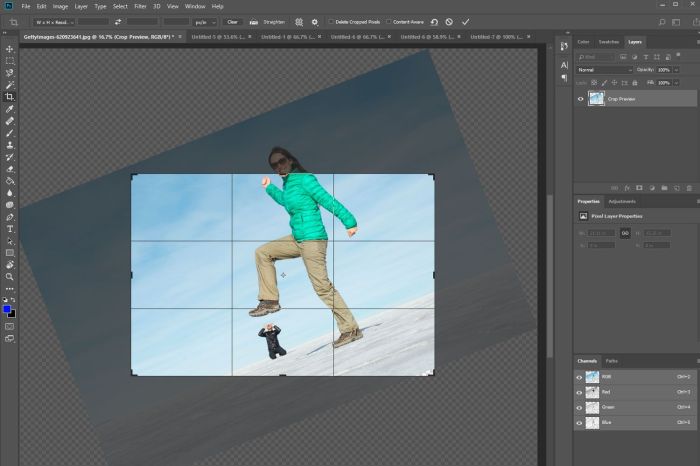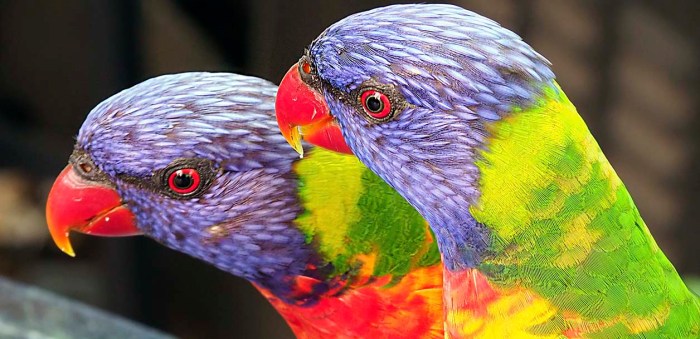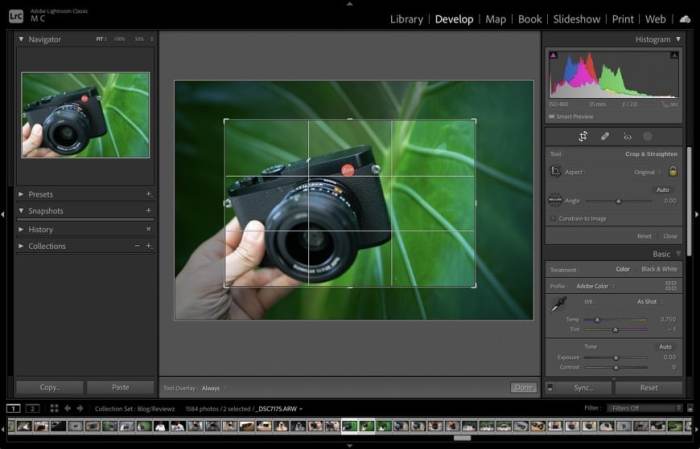Mastering image cropping is key to impactful visual communication. This guide delves into seven creative framing techniques, transforming ordinary images into compelling design elements. We’ll explore fundamental composition principles, discuss various cropping ratios and their effects, and examine how perspective and negative space contribute to a design’s overall message. From understanding the rule of thirds to leveraging leading lines, we’ll equip you with the skills to elevate your designs.
We’ll cover the practical application of these techniques across diverse design contexts, including website and print media, demonstrating how strategic cropping enhances visual hierarchy, storytelling, and the overall impact of your work. Prepare to unlock the full potential of your imagery.
Understanding Composition and Cropping Techniques

Effective image cropping is intrinsically linked to understanding the principles of composition. By strategically cropping an image, you can dramatically enhance its visual impact, guiding the viewer’s eye and conveying a specific mood or message. This section will explore key compositional techniques and their application in image cropping.
The Rule of Thirds and Its Application
The rule of thirds is a fundamental guideline in photography and graphic design. It suggests that an image should be imagined as divided into nine equal parts by two equally-spaced horizontal lines and two equally-spaced vertical lines, and that important compositional elements should be placed along these lines or their intersections. Applying this rule in cropping involves positioning key subjects or focal points along these lines rather than centering them. This creates a more dynamic and visually engaging image, preventing a static, uninteresting feel. For example, imagine a landscape photo; instead of centering the horizon, cropping it to place it along the lower horizontal line emphasizes the sky and creates a sense of openness. Conversely, placing the horizon on the upper line emphasizes the foreground and grounds the image.
Cropping Ratios and Their Suitability
Different cropping ratios alter the aspect ratio of an image, influencing its overall feel and suitability for various media. Common ratios include 16:9 (wide, ideal for widescreen displays and videos), 4:3 (a more traditional ratio, suitable for prints and some online platforms), and 1:1 (square, often used for social media profiles and aesthetically pleasing symmetrical compositions). The choice of ratio depends on the image content and intended use. A landscape photograph might be best suited to a 16:9 ratio to emphasize its horizontal expanse, while a portrait might benefit from a 4:3 or even a 1:1 ratio to highlight the subject’s vertical orientation.
Best Practices for Emphasizing Subjects and Creating Visual Balance
Cropping effectively involves more than just trimming edges. It’s about strategically removing distracting elements and focusing attention on the main subject. To emphasize a subject, crop tightly around it, removing any unnecessary background clutter. Consider the negative space around the subject – a well-placed empty area can create visual breathing room and enhance the subject’s impact. Maintaining visual balance is crucial; avoid disproportionate cropping that leaves the image feeling lopsided or unbalanced. Imagine cropping a portrait – removing too much space around the head might feel claustrophobic, while too much empty space could make the subject feel lost. The goal is to find a balance that highlights the subject while creating a harmonious composition.
Effects of Different Cropping Techniques on Mood and Message
The following table demonstrates how different cropping techniques can alter the mood and message conveyed by an image. Consider these effects when selecting the appropriate crop for your specific needs.
| Cropping Ratio | Effect on Mood | Effect on Message | Example |
|---|---|---|---|
| 16:9 | Wide, expansive, cinematic | Emphasizes breadth, scope, or journey | Landscape photography showcasing a vast horizon. |
| 4:3 | Balanced, classic, versatile | Suitable for a wide range of subjects and messages | A portrait photo showcasing a person from the chest up. |
| 1:1 | Symmetrical, intimate, focused | Highlights a specific detail or creates a strong visual focus | A close-up shot of a flower, emphasizing its intricate details. |
| Tight Crop (extreme close-up) | Intense, intimate, emotional | Focuses on specific details, evokes strong feelings | A close-up of a person’s eyes conveying a particular emotion. |
Exploring Creative Framing and Perspectives

Cropping isn’t just about removing unwanted elements; it’s a powerful tool for shaping the narrative and emotional impact of your image. By carefully selecting what to include and exclude, you can dramatically alter the viewer’s experience and guide their attention precisely where you intend. This section will explore how different viewpoints and the strategic use of negative space can elevate your image design.
Different viewpoints significantly influence the emotional resonance of a cropped image. A high-angle shot, for instance, can create a sense of vulnerability or insignificance in the subject, making them appear smaller and more exposed. Conversely, a low-angle shot can convey power and dominance, emphasizing the subject’s size and importance. Eye-level shots, on the other hand, offer a more neutral and relatable perspective, fostering a connection between the viewer and the subject.
Viewpoint Impact on Cropped Images
High-angle shots, by cropping out the surrounding environment and focusing on the subject from above, often evoke feelings of helplessness or vulnerability. Imagine a cropped image of a lone figure standing in a vast field, shot from a high angle; the vastness of the field, emphasized by the cropping, accentuates the figure’s smallness and isolation. Low-angle shots, in contrast, achieve the opposite effect. By cropping out the top of the frame, focusing on the subject from below, you emphasize their size and power. Consider a cropped image of a towering building, shot from a low angle; the building’s imposing height, enhanced by the close cropping, projects an image of strength and dominance. Eye-level perspectives offer a balanced approach, creating a sense of intimacy and connection with the subject. A cropped portrait, for example, shot at eye level, allows the viewer to connect directly with the subject’s expression and emotions.
Cropping and Leading Lines
Cropping can be used effectively to create and emphasize leading lines, directing the viewer’s gaze through the image. Leading lines, naturally occurring or artificially created, draw the eye towards a focal point. Cropping can enhance this effect by isolating the lines and their relationship to the subject. For example, a road stretching towards the horizon can be dramatically enhanced by cropping out distracting elements on either side, focusing attention on the path and the subject at the road’s end. Similarly, architectural lines within a building can be strategically cropped to guide the viewer’s eye towards a central feature.
Effective Use of Negative Space in Cropping
Negative space, the empty area surrounding the subject, is not simply an absence of content; it’s a powerful design element. Strategic use of negative space in cropping can significantly impact an image’s visual impact.
Here are three distinct ways to leverage negative space:
- Isolation and Emphasis: Surrounding the subject with ample negative space isolates it, drawing immediate attention to it. This technique is particularly effective for showcasing a product or a person’s portrait.
- Creating Balance and Harmony: Carefully balancing the subject with negative space can create a sense of calm and serenity. A minimalist approach, where the subject is small within a large negative space, can be very effective.
- Suggesting Movement or Context: Negative space can also suggest movement or provide context. A small figure walking along a vast beach, cropped to emphasize the empty space around them, suggests freedom and isolation. The vastness of the beach becomes an integral part of the story, not just an empty background.
Subject Isolation Through Cropping
Imagine a photograph of a bustling city street. The original image shows a multitude of people, buildings, and vehicles. By cropping tightly around a single individual, perhaps a street musician, the background becomes a blurred, almost abstract representation of the city’s energy. The musician, sharply in focus, is now the undeniable center of attention. The cropping isolates the subject, transforming them from a small part of a busy scene into the sole focus, emphasizing their importance and allowing their story to be told more effectively.
Applying Cropping in Different Design Contexts

Cropping, a seemingly simple act, profoundly impacts the visual impact of a design. Its application varies significantly depending on the medium – whether it’s the dynamic world of website design or the more static nature of print. Understanding these nuances allows designers to leverage cropping for maximum effect.
Cropping in Website Versus Print Design
Website design demands adaptability. Images must resize smoothly across various screen sizes and resolutions. Cropping for the web often prioritizes creating multiple versions of an image, each optimized for specific display dimensions. This ensures a clean and consistent presentation, regardless of the device. Print design, conversely, offers more control. The final output is predetermined, allowing for precise cropping to achieve a specific aesthetic. The designer can work with higher resolution images and fine-tune the cropping for the exact print dimensions, without worrying about responsiveness. A print advertisement might utilize a tightly cropped image to focus attention on a key detail, whereas a website banner might employ a looser crop to accommodate various screen sizes while maintaining visual appeal.
Cropping to Create Movement and Dynamism
Cropping can be a powerful tool to create a sense of movement within a still image. By strategically isolating a portion of the image, a designer can guide the viewer’s eye and suggest action. For instance, cropping a photograph of a runner to show only their legs and torso in mid-stride creates a feeling of speed and momentum. The implied movement is far more potent than showing the entire runner, potentially diluting the focus on the action. Similarly, cropping a landscape photograph to emphasize a diagonal line can create a sense of depth and movement, leading the viewer’s gaze across the scene. The strategic removal of distracting elements enhances the sense of motion.
Improving Visual Hierarchy Through Cropping
Effective visual hierarchy guides the viewer’s eye through a design. Cropping can significantly improve this process.
- Identify the Focal Point: Determine the most important element in your design.
- Crop to Emphasize: Use cropping to isolate the focal point, removing any competing elements that might distract from it.
- Use Scale and Proximity: The size and position of the cropped image within the overall design can further enhance its prominence.
- Consider Negative Space: Strategic use of negative space around the cropped image can also draw attention to it.
- Test and Iterate: Experiment with different crops to see how they affect the visual hierarchy. A/B testing different versions can reveal the most effective approach.
Cropping to Enhance Storytelling in Image Series
A series of images can tell a compelling narrative, and cropping plays a crucial role in shaping this story. Consider a series depicting a character’s journey. The first image might show a wide shot of the character at the start of their journey, establishing the setting. Subsequent images could progressively use tighter crops, focusing on the character’s facial expressions and body language as the story unfolds. This technique creates a sense of intimacy and involvement, drawing the viewer deeper into the narrative. For example, a series depicting a climber ascending a mountain could start with a wide shot showcasing the mountain’s grandeur, followed by closer shots focusing on the climber’s hands gripping the rock face, emphasizing the challenge and effort involved. The final image might show a close-up of the climber’s triumphant expression at the summit. This progression, guided by careful cropping, builds tension and emotional impact.
Closing Summary

By understanding composition, perspective, and the strategic use of negative space, you can harness the power of image cropping to create visually stunning and impactful designs. Remember, cropping isn’t just about removing unwanted elements; it’s about carefully framing your subject to convey a specific mood, guide the viewer’s eye, and ultimately, enhance your storytelling. Experiment with different techniques, find your style, and watch your designs flourish.